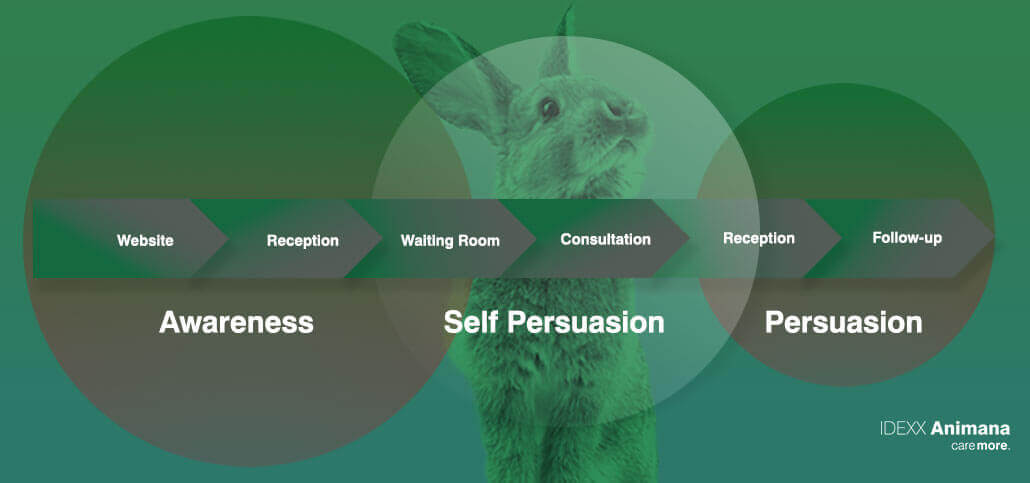Is your message heard?
Flea-treatments, de-worming, sterilisation, castration, and vaccinations… These are subjects you discuss several times a day. But how much of what you say is being heard by the animal owner? Do you often emphasise the importance of treatment and wonder if your message gets through? The key to getting your message across lies in persuasion and focus.
Self-persuasion
Do you recognise yourself in the above story? If so, self-persuasion is the solution, and you are probably already using it to some degree in your practice right now.
Self-persuasion is the process where a pet owner persuades themselves to take a particular cause of action. The key is that the reasoning and motivation come from within themselves.
The three characteristics of self-persuasion
Convince
As a veterinary practice, you and your staff are seen by your customers as an expert. You can directly communicate passively – for example a poster in the waiting room, or it can be actively – such as having a conversation.Time to process
Self-persuasion needs time to sink in. As a trained veterinary professional, you reach decisions much faster than your customers. So once customers have all the knowledge they need – give them adequate time to process a message, and reach a decision.Autonomy
Self-persuasion only works if the pet owner has the autonomy to reach their own decision. So be careful not to take severe actions to push a decision a certain way.
Focus
Practices communicate a lot of different messages. A waiting room can be awash with posters for new products, medicines and treatments – you wish to inform and tempt the owner to buy a product. However, are your pet owners getting lost in a sea of information? Best practice shows us that if you want to communicate effectively with customers, keep everything relevant and offer value. Ask yourself – as a customer – are your messages focussed?
How to convince your customers
Keep communications relevant and offer value, start at your website and your waiting room. Do you have old notices about team outings, staff changes or lost-pet notices? Ask yourself if each of these have value and offer consistent messaging to your pet owners? For example, are you presenting a unified message about preventative care such as flea treatment, deworming or annual vaccinations?
Try to ensure focus throughout your customers’ journey through your practice. Make sure you choose a topic that is relevant to your customers and repeat or reinforce it at different points throughout the customer journey.
Putting it into practice…
A pet owner discovers that their pet has blood on one of their paws but the owner has been unable to find the cause, so wishes to go to the vet.
Website:
The pet owner uses the internet to check the veterinary practice contact details. The website is clear and the owner finds the information and makes an appointment. During this experience, the owner sees some preventive care messages on the practice’s website.
Reception:
Upon entering, the owner reports at the desk, during which the pet’s health status is reviewed. The questions asked highlight that the owner is not aware of appropriate preventive health as the pet has not recently had flea treatment. The paraveterinary worker at the desk shares informal preventive care with the owner before asking the owner to take a seat.
Waiting room:
While waiting, the owner notices posters, flyers, and a presentation on a television screen all which focus on preventive care.
Consult:
Time is limited during a typical 15-minute consultation, so there is not much time for general communication, but because the owner has been primed, it’s easy to start a conversation about flea and worm control. The veterinarian can answer any questions, all the time strengthening the owners self-persuasion.
Reception:
Before checkout, the paraveterinary worker can re-enquire about flea or worming prevention – continuing the previous discussion. The owner also has the chance to make a purchasing decision.
Follow-up:
Once the owner has left the clinic, they have time to process the messages heard at the clinic, and take action. However, if no action has been taken after a couple of weeks, it’s a great opportunity to send an automatic reminder reinforcing the importance of preventative care.
Related Links
- A flawless customer journey, it all starts in the waiting room! Part 1 | Part 2
- Learning Path: Automated Reminders
Let’s talk about what IDEXX software can do for your practice
Complete the form below and we’ll get back to you.








